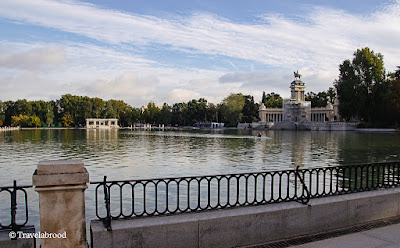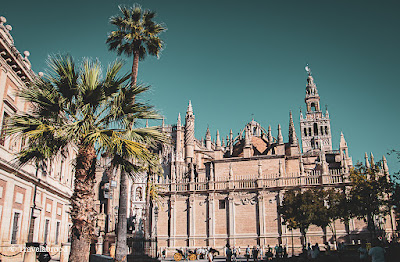MADRID, CORDOBA, SEVILLE & CADIZ
(and a day trip to Segovia)
September 2023
Our recent trip to Spain and Portugal had been in the making for a least two years. We booked our flights with extra-legroom seats as soon as we could and avidly watched Somebody Feed Phil and James Blick's Spain Revealed YouTube channel to whet our appetite even further.
Arriving in Madrid we were on the hop to drop our bags at The BLESS Hotel before heading straight out to our late lunch booking at restaurant Botin. Founded in 1725, Botin (according to the Guinness Book of Records) is the earliest restaurant in the world and is famous for its suckling pig. We don't usually get caught up in touristy restaurants; however, Botin is an institution and there was no better way to spend a drizzly Sunday afternoon, tired and hungry than having a very yummy lunch.
When you think about Spain, you automatically think about bullfighting and Matadors. The Las Ventas Bullring is the largest bullring in Madrid and third largest in the world. Event tickets are sold in zones according to the position of the sun and shade. Alternatively, you can take a tour of the facility or just visit the bullfighting museum.
Madrid is a fabulous walking city. The streets are wide, very clean and most museums and tourist attractions are within walking distance of each other. Calle Gran Via is Madrid's best-known avenue, so if you find your way there, then the city is very easy to navigate. The best rooftop for views across Madrid is at the Circulo de Bellas Artes. Few tourists know about it as entry is through the glass doors to the side of the building and there is an entry fee. However, the views put the city into perspective and you can stop and have lunch or a drink while watching the buzz of traffic below.
If you've done any research into visiting Spain, then you would know that the structure of their day is quite different. Compared to most countries, Spaniards eat at odd times. Breakfast is usually around 10am-11am, lunch 12pm-3pm and dinner 9pm-11pm. You can have Tapas any time of the day, however anyone eating a meal between 6pm - 9pm is considered a tourist and is most likely eating a picture paella (ie: heated up for mass consumption). Taking this into consideration, we decided to have our main meal at lunchtime and then visit the markets or tapas bars for a snack in the evenings. My advice is to book your restaurants in advance as to avoid disappointment.
 |
| El Retiro Park |
We stayed in the Salamanca district just north of the El Retiro Park and close to luxury boutiques and upmarket homes. The Mercado de la Paz was our go-to for fresh fruit, snacks, oysters and glass of wine (or two). Tepic Mexican is also located in Salamanca, where we had a very memorable lunch.
 |
| Mercado de la Paz |
When planning a trip, it is best to book all your tours and 'jump the queue' tickets online. Tour buses are a plenty and the crowds can be quite overwhelming. We took a late afternoon guided tour of the Prado Museum by Headout. Our tour guide, Benito, was a wealth of knowledge, easy to understand and passionate about the history of the artists and paintings. After an hour and a half, we were left to explore the rest of the Prado on our own. Don't forget to check the closing times, as often a late afternoon or last ticket entry into popular museums is less busy.
If you want to avoid large crowds and get an insight into the daily life and customs of the high bourgeoisie during the Romanticism period, then plan a trip to the Museo del Romanticismo. The home was donated to the state in 1921 and is a showcase of art, furniture and valuable objects.
Madrid has a lot of beautiful green spaces. The Temple of Debod, is an ancient Egyptian temple which was dismantled and then rebuilt in the Parque del Oeste as part of the International Campaign to save monuments of Nubia. Walking through the park, you then reach the Campo del Moro and the Royal Palace. Used mostly now for official functions, the palace is one of the few in the world that is open to the public.
 |
| Temple of Debod |
The Teatro Real or Opera House was voted as the best in the world in 2021. Unfortunately, we were unable to do the self-guided audio tour as it was opening night and rehearsals were on.
Devour Tours combine history and food into their walking tours. The Tapas, Taverns and History tour with ex-chef Jose was a great way to experience the city and jump the queue into some of the oldest and best eateries.
 |
| Our very lovely guide Jose |
 |
| Garlic prawns & Vermut at La Casa Del Abuelo |
To market, to market..... Madrid has some of the best markets with the most popular being the Mercado San Miguel. Located close to the Plaza Mayor it is a popular eating spot for locals and tourists alike. It is probably more on the touristy and expensive side than other markets, but it is worth the visit if not for the food, then the architecture.
SEGOVIA
 |
| Segovia |
Trains from Madrid to Segovia run frequently and take around 30 minutes from Madrid-Chamartín Station. Once you arrive in Segovia, it's best to take a taxi to the Alcazar located at the top of the hill and then spend the day meandering your way down to the Aqueduct.
The Alcazar of Segovia is a very impressive medieval castle. Built around the 11th century, the fortress is built into the rock at the western end of the Segovia's old town. Throughout the centuries it has been used as a palace, military fort and now museum and UNESCO world heritage site. The amour collection is exceptional, along with the tapestries, frescos and tiles. I can't imagine how many lives have been tossed off the imposing structure. Timed tickets for the museum and Torre de Juan II (tower) are best bought online.
From the Alcazar follow Calle Real to the Plaza Mayor (town centre) and the Cathedral. The Gothic styled church was built between 1525 and 1577 and is dedicated to the Virgin Mary.
The tradition of roasting suckling pig holds a special place as a cultural and gastronomic heritage of the Segovian community. Since 1982, restaurant Jose Maria have been serving this delicacy showing off its tenderness by carving the roasted pig with a plate.
After lunch, wander down to the Aqueduct via Puerta de San Andres (Gate of Saint Andrew) and the Jewish Quarter, located in the south of the walled city.
The Aqueduct of Segovia was built around the first century AD. The 167 granite arches and the unmortarted brick-like ashlars are ingeniously connected using the principles of force equilibrium. It is one of the best-preserved Roman aqueduct bridges and the foremost symbol of Segovia.
Stop for gelato near the aqueduct before grabbing a taxi back to the station.
CORDOBA
Cordoba is historically one of the oldest and most important cities in Spain. Located on the Guadalquivir River, Cordoba was once a Roman settlement before being taken over by Visigoths and later Muslim's. There is so much to see and understand about Cordoba that the best way of doing it is on a private walking tour with a local. Toni from Tours by Locals grew up in Cordoba and has dedicated her career to educating people on the history of the city. Toni makes the tour very interesting regaling stories of a past time while you explore the Mosque-Cathedral, Alcazar of Christian Kings, Jewish Quarter and Private Courtyards.
 |
| The Courtyards Festival of Cordoba is held in May each year. |
Upon arriving in Cordoba our host told us the best way to visit was to just get lost in the maze of narrow alleyways that lead you to Roman ruins, the river, plaza's and restaurants such as Argus and Taberna La Montilana.
SEVILLE
Following the Guadalquivir River, our next stop is Seville. Arriving in 37°C heat our best option of seeing the city was by hop-on hop-off bus. Seville is twice the population of Cordoba and a very easy city to navigate. Most of the tourist attractions such as the Cathedral, Alcazar and old town are close together and the city has a lot of green space such as the Maria Luisa Park and Plaza de Espana. A light rail traverses the city centro.
Founded in the early Middle Ages and built for King Peter of Castile, the Alcazar of Seville is one of the most beautiful palaces in Spain. The Royal Family still have quarters within the Alcazar; however usually prefer to stay at the Alfonso Hotel XIII (where we enjoyed dinner at the courtyard restaurant San Fernando). The best way to visit the Alcazar is on a 'visit with a guide'. The hour-long tour gives you the right amount of information including stories of hidden doors and missing tiles. Without a guide you are following a conga line of tourists looking at empty rooms and pretty gardens.
The Cathedral is next to the Alcazar and once you've exhausted yourself with history, then stop for a very yummy lunch at La Azotea.
CADIZ
Cadiz is the oldest city in Western Europe and near where the Guadalquivir River meets the Atlantic Ocean. It is also the city from which Christopher Colombus embarked on his second voyage in 1493. For a not so big city, it has a lot to offer including the Cathedral de Cadiz, the Gadir Archaeological site, the Castle of Santa Catalina, Genoves Park and the Tavira Tower where you will get the best views of the city.
Each year in February, Cadiz becomes a huge party town with the Cadiz Carnival. Celebrated along the lines of Carnivale in Rio, locals take to the streets singing and dancing wearing costumes and celebrating long into the night.
We stayed in the very stylish apartment hotel La Casa del Consul. Owners, Eric and Vittore greeted us like long lost friends into their home and made sure we had all the right information as well as lunch and dinner reservations at some of their local favourites. The apartment was more than comfortable and the rooftop terrace was an enchanting place to relax.
 |
| La Casa del Consul Rooftop |
The worst thing about Cadiz was that we didn't stay long enough. It was so pleasant being by the ocean and exploring the streets of the old town. The food, the markets, what's not to love about Cadiz?


















No comments:
Post a Comment